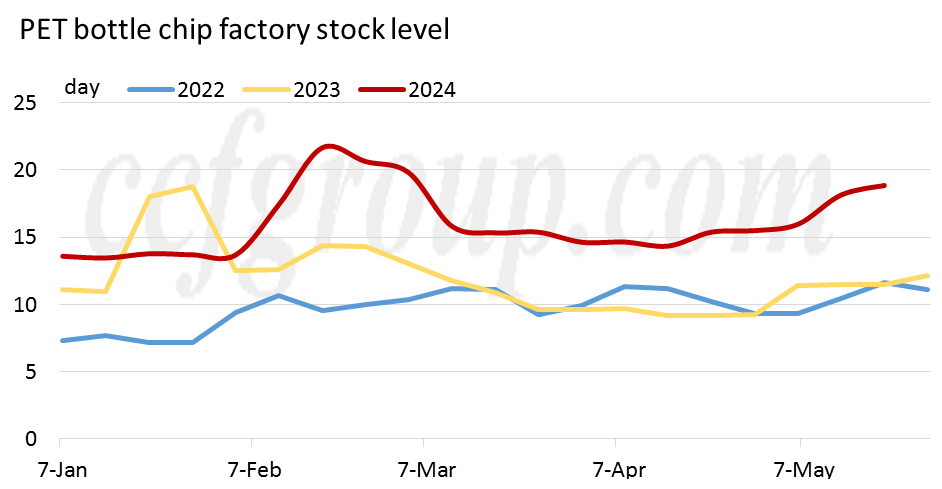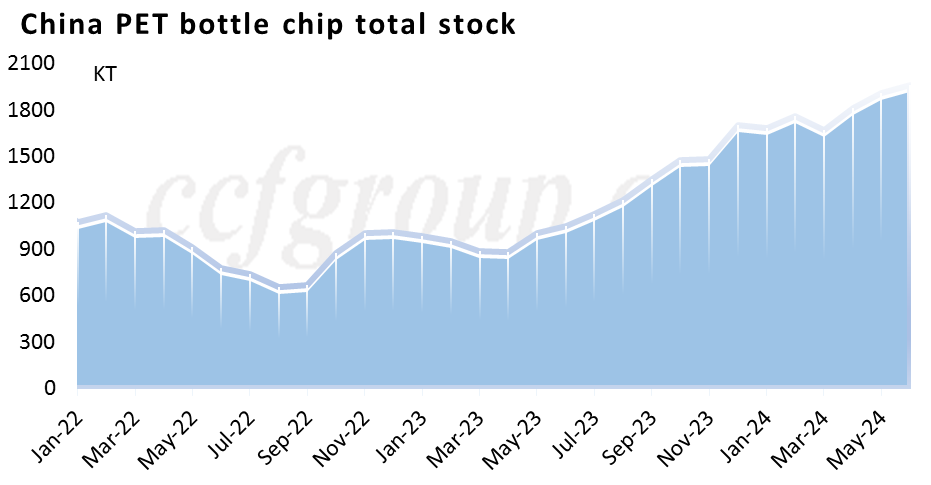China PET bottle chip export delivery volume declines MOM
Since May, the delivery speed of PET bottle chip in the domestic and international markets has significantly slowed down compared to the previous month. As of last weekend, the average inventory of domestic PET bottle chip factories has increased by approximately 4-5 days, nearly doubling compared to the same period last year. Normally, large downstream factories tend to reduce production after intensive production in March and April, leading to a slowdown in delivery speeds. Furthermore, since many small and medium-sized customers purchased downgraded products this year, traders are facing increased contractual inventory pressure, contributing to the rise in factory-side inventory. The short-term weakening of domestic demand may be related to seasonal factors, the unexpected inventory pressure has been brought to PET bottle chip manufacturers due to sudden export shipment disruptions (some inventory may need to be redirected for domestic consumption).

Recent observations suggest that PET bottle chip factories have been facing delivery obstacles for export orders since late April, with some factories reporting about 20% delays in April orders. Most factories anticipate a further reduction in shipments in May, estimated to reach around 30%. Currently, these factories are gradually considering increasing the proportion of bulk cargo shipments to minimize contract execution issues caused by delays in shipping schedules. Customs data indicates that after reaching a historic high in March, the monthly export delivery volume of PET bottle chip in April increased by over 20% year-on-year, but the month-on-month growth rate decelerated by approximately 11%.
Following the shortage of container supply, export sea freight rates have sharply risen after the Labor Day holiday in May. It is reported that freight rates from China to certain South American ports have exceeded $10,000 per TEU, averaging around $400-500 per ton. Freight rates to the European Union have reached $200-300 per ton, with fluctuating prices, making it challenging to secure shipping space even with sufficient funds. Overall, current sea freight rates are gradually approaching or surpassing the peak levels seen during the pandemic.
The maritime market is once again experiencing container shortages, a problem rooted in the global supply chain imbalance. On one hand, a large number of goods from Asia need to be transported to Europe and North America to meet local market demands; on the other hand, there is an insufficient transportation of goods back to Asia from Europe and North America, resulting in high costs associated with returning empty containers. Many shipping companies prefer leaving containers idling in local ports rather than returning them to Asian ports since storage costs are lower than shipping fees. Therefore, after the initial capacity shortages, shipping companies briefly considered increasing the number of vessels. However, the supply shortage of containers has once again become one of the contradictions hindering the flow of goods.
Based on the recent scarcity of shipping space and the situation of delayed shipment schedules, it is projected that all the PET export orders in the second quarter may face delays until July. Even though bulk cargo vessels can be used for large orders, the cost of consolidating smaller orders for medium and small customers is not trivial. The priority of shipping for smaller orders is relatively low, and the potential delays in shipments may reach 10-20% or more every month.

Therefore, if more than 4 million tons of new capacity in the PET bottle chip sector are put into operation as planned and the export delivery speed remains constrained, then by the end of the second quarter to the third quarter, the inventory of PET bottle chip factories may once again rise. At that time, the total inventory may exceed 2 million tons, with factory inventories approaching 1.2-1.3 million tons temporarily, surpassing the total demand digestible by the market within a month. News of plant shutdowns may resurface during this period.
- Top keywords
- Cotton Price
- Cotton Futures Price
- Cotton Futures
- CZCE
- PTA Futures Price
- Chemical Fiber
- Polyester Prices
- Wool price
- PTA Futures
- Shengze Silk
- China
- Yarn Price
- price
- China Textile City
- Fibre Price
- Benzene Price
- Cotton
- Index
- Cotton Index
- PTA
- fabric price
- NYMEX
- Top 10
- textile industry
- Spot Cotton
- Cotton Yarn
- Polyester Price
- Futures
- PTA Price
- cotton yarn price

